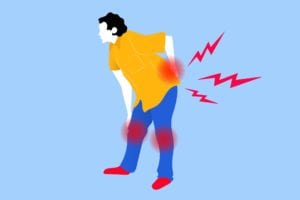Axial spondyloarthritis (axSpA) is often described as an inflammatory form of arthritis that causes low back pain. While chronic back pain is usually the major feature of axSpA, this condition may cause symptoms in other areas of the body as well. In fact, many patients end up developing arthritis in one or more peripheral joints, according to a new study published in the journal Arthritis Research & Therapy.
Researchers recruited 708 patients from a group of French arthritis patients who had been diagnosed with early inflammatory back pain that suggested they probably had axSpA and followed them for five years. During that time, 36 percent of patients developed arthritis in at least one peripheral joint — most often in the lower limbs.
Peripheral arthritis appeared to strike more often in axSpA patients who were older (at least 33 years old), non-smokers, and negative for HLA-B27 antigen (a protein that’s sometimes associated with axSpA).
Those who developed peripheral arthritis were also more likely to develop an inflamed toe or finger and enthesitis (an inflammation of the spot where tendons or ligaments attach to bone).
While non-steroidal anti-inflammatory drugs (NSAIDs) are considered the first-line treatment for axSpA, patients who went on to develop peripheral arthritis were more apt than those who did not to require stronger medications, such as TNF inhibitor biologics. Not surprisingly, they also missed more work and reported worse quality of life.
The authors suggested that rheumatologists should be routinely monitoring axSpA patients for peripheral arthritis so they can treat those who develop it accordingly.






